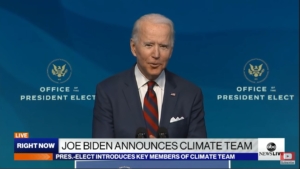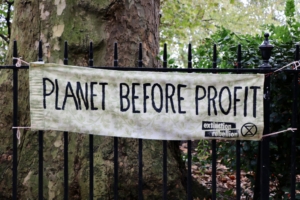Bloomberg’s Beyond Carbon Is a Big Deal, Scooter Surveillance, and Innocent Until Predicted Guilty
Here’s What You Need To Know
After seriously exploring the possibility of running for president as a Democrat in 2020, former New York City mayor Michael Bloomberg announced last month that he will be one of the few Democrats not pursuing the nation’s highest elected office. For those who appreciate the freedom to enjoy a large soft drink or exercise their Second Amendment rights, this was welcome news. However, Bloomberg made clear that he will not be heading quietly into retirement. Instead of The White House, he announced a new initiative to bring his talents – and estimated $55 billion fortune – to bear on a new “grassroots effort” called Beyond Carbon “to begin moving America as quickly as possible away from oil and gas and toward a 100 percent clean energy economy.” Bloomberg’s launch of Beyond Carbon is a big deal, and most of the media coverage missed its serious public policy and business implications.
With the enthusiasm surrounding the Green New Deal, which has become a household name and supported by a plurality of voters despite its lack of detail, Bloomberg’s involvement means that not only the energy industry, but potentially millions of people whose jobs are at stake, must begin preparing for a major public policy fight. Here’s what you need to know about Beyond Carbon:
- Beyond Carbon Is Bloomberg’s Latest Well-Funded Effort: To gauge the impact of Bloomberg harnessing the energy of the Green New Deal, it is best to examine the success he has achieved with his existing Beyond Coal campaign, which will be expanded under Beyond Carbon. Over the past decade, Bloomberg has committed more than $100 million to the Sierra Club’s effort to retire every U.S. coal-fired power plant. This campaign has been remarkably successful, having helped close over half of the country’s coal power plants. Given how much he has spent on environmental and gun control efforts to date, as well as how much he was preparing to spend on 2020 presidential politics, it can be expected that significant resources will be brought to bear on this new anti-carbon initiative.
- Cleaner Carbon Is No Longer Welcome In The Clean Revolution: Not long ago natural gas was considered to be the cornerstone of the clean energy revolution. The move beyond coal to now target any carbon-emitting fuel, including natural gas, is endemic of a rising attitude among environmental activist groups that any fossil fuel use must be rapidly eliminated in its entirety. Particularly with a benefactor like Bloomberg, who is flush with cash and a veteran of waging vigorous issue campaigns, there is no reason to believe that this effort will stop at natural gas. And it does not matter that there are few if any readily available clean alternatives that can provide reliable and consistent energy, as demonstrated by the challenges facing state governments across the U.S. increasingly setting 100 percent renewable energy goals that ignore this reality.
- Beyond Carbon Is Beyond Affordable: While Bloomberg can afford the costs of moving beyond carbon, most Americans cannot. Issue campaigners, such as those pushing for unrealistic renewable energy goals, give little regard to the unsustainable and unnecessary costs that their policies have and the impact on cost-of-living, quality of life, job prospects, taxes, and more. Instead of standing for election and winning a mandate, Bloomberg and other activists like Tom Steyer choose manipulative issue campaign efforts where the subsidies and costs fall on those who can least afford them without having to secure a mandate at the ballot box first. A recent example of this untenable position is the bankruptcy of California’s Pacific Gas & Electric (PG&E). Moody’s recently estimated that PG&E, one of the country’s largest utilities, pays an estimated $1.4 billion annual in above-market renewable power purchase agreements that were created to help achieve the state’s renewable energy goals. Such costs are born by ratepayers and taxpayers and are a drag on jobs and economic growth.
- It’s Time For Energy To Defend Its Reputation And Future – For All Our Sakes: For the energy industry, now is a moment of truth. Rather than provide concessions and placate environmental activists backed by a few well-placed billionaires, now is the time to gear up to address this threat to the industry, the economy, and the millions of families who depend on these jobs. This is a major public policy fight against an opposition that sees no legitimate purpose for fossil fuels, and no amount of money spent on conservation initiatives or corporate social responsibility programs will change their minds, or their ultimate objective. If the industry does not stand up now for the legitimate purpose they serve, and high quality of life that their products make possible, no one will. With Bloomberg’s declaration of war, even a negotiated surrender is no longer an option.
To protect their interests, energy companies must aggressively defend their industry – and the prosperity it provides to millions, if not billions, of people around the world – against the well-funded and well-organized efforts targeting it. If they choose not to, Bloomberg’s decision to not run for president (irrespective of new rumors that he may change his mind and reverse course) may ultimately prove to be one of the most consequential moments for America’s future, regardless of who wins the presidency in 2020.
News You Can Use
SCOOTER SURVEILLANCE
Subscribe to Receive Insights
"*" indicates required fields
Electric scooters have multiplied by the thousands in urban areas around the U.S., and so have the political and reputational risks for local governments and companies in this very new industry. The Los Angeles Department of Transportation (LADOT), eager not to let a good craze go to waste, last year told scooter suppliers that they would soon be required to provide the agency with location data of their user’s rides, or they would face strict permit and fleet size regulations.
While the agency says it keeps a lock on customer privacy, the actual details are somewhat murky: LADOT recently partnered with a third-party data aggregation company, Remix, that will analyze consumers’ scooter riding patterns for an undisclosed purpose. Just as one should put on a helmet before renting a scooter, those public and private entities rushing in to capitalize on the scooter obsession should pause to consider the increased web of risks they face from the burgeoning space so that they may better anticipate and overcome challenges when they inevitably arise.
DOGGED PURSUIT OF THE FACTS
Not every place you see on your map is what it seems. In the case of Patrick’s Park in San Francisco, it may not even be a real place at all. One pet owner named a small green parcel of land, previously unnamed, unmappable, and forgotten between notable locations, on Google Maps after his dog so that friends could meet up there.
It then took on a life of its own, first becoming an underground tourist destination, and then the location for an elaborate “St. Patrick’s Day Dog Parade” with pet industry influencers, a costume contest, music, and more to solidify its status as a real place. This light and comical episode demonstrates the convenience and connections that the internet brings to everyday life, yet also serves as a reminder of the important role that highly-trained analysts play in assessing real information from multiple sources in dogged pursuit of the facts, rather than just believing whatever pops up on Google.
INNOCENT UNTIL PREDICTED GUILTY
With the backlog of U.S. security clearances piling due to an “antiquated” system of background checks, a new project in the works from the U.S. Defense Security Service (DSS) seeks to not only paint a picture of an individual’s past behavior; it could theoretically be used to indicate a person’s future as well. The DSS project’s pilot test will collect massive amounts of data on individuals including internet browsing data, tax records, and travel plans to form a “digital footprint” of a person.
Altogether, these “digital footprints” create a complex network of standard human behavior ready for analysis by artificial intelligence (AI) programs. Small deviations in an individual’s routine could inform employers of an employee’s higher likelihood of stress, secrecy, or other undesirable traits. While this may in theory help bring the clearance process into the 21st century and lessen the backlog, it raises questions about whether its predictions are accurate or not (and AI platforms have already been found to have a racial and gender bias, adding a discrimination element to the equation); if such an algorithm is therefore a good idea; and, what the recourse would be for those who feel that their reputations are unfairly maligned.
FACEBOOK’S NEW RESEARCH TOOL
Directly in the crosshairs of government regulators looking to bring some transparency to the depths of social media, Facebook hopes to beat them to the punch with a new research tool that can help users anticipate and understand how advocacy networks are trying to influence them using the platform. The tech giant recently launched an advertising transparency page allowing curious minds to search a database of active advertisements, when they were created, and the pages that manage them. Political and issue ads will show a wealth of detail in terms of the ad’s funding sources and its overall visibility on the site.
It’s unclear whether this self-regulation will be enough to stave off politicians who want to hold Facebook accountable for its immense power, but it may be viewed as a good start. In the meantime, as fake accounts and others whose motivations and backgrounds may be different than they appear perpetuate on social media platforms, understanding who or what is behind what you see online will remain an important skill.



